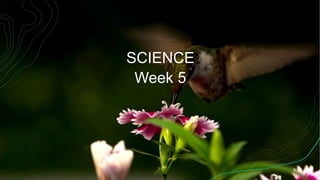
Science Week 5.pptx
- 2. Changes in Materials In this new lessons, you are expected to describe changes in the properties of materials when exposed to certain conditions such as temperature or when mixed with other materials.
- 3. Try to sip some iced tea or cold water while you are going through all the learning tasks in this module. What did you feel? Don`t you know that cold water have more dissolved oxygen that`s why it feels better to sip cold drinks than a non-cold drinks? Recall what happened to ice cubes when they were exposed to heat. The ice cubes melted. What made the ice cube melted? See figure 3. below.
- 5. Effect of Temperature in the Phases of Materials At constant pressure, the state of materials depends on the temperature by which they are exposed. The ice cube or the solid phase of water, as seen in Figure 3 above will melt if taken out of a freezer and stayed long at room temperature. The water that boils turned into gas or vapor that comes out of the kettle if left at high temperature for too long.
- 6. Temperature is the measurement of the amount of heat energy present in the surroundings. There is an exchange of heat between the substance and the surroundings. This means that heat can be absorbed by the materials or can be released by the materials.
- 7. When the heat is absorbed by the materials, the temperature will increase, thus the material is hot. If heat is removed or released by the materials, temperature will decrease, thus it is cold.
- 8. Temperature varies depending on the environment from where the materials are exposed. For example, we feel very hot during summer days because of the intense heat of the sun. Some places in our country registered a temperature of 40 °C.
- 9. This is very hot because our normal body temperature is about 37 °C. If your temperature is above 37°C , you may experience fever. This is the reason why you are advised by doctor to take medicine and take plenty of water to lower the temperature.
- 10. Another changes in the materials due to the application of heat is called melting. This process that happens when solid material changes into liquid form. The heat coming from the environment made the ice cubes melted when they are removed from freezer.
- 11. The temperature in the freezer is O °C (read as zero degree centigrade or zero degree Celsius). Thus, when ice cubes were exposed to heat in the environment, the high temperature of the environment caused the melting of ice cubes.
- 12. Generally, an increase in the temperature turns solids into liquids (melting), liquid to solid (freezing), liquid into gases (evaporation), solid into gas (sublimation), and boils water at certain point (boiling ).
- 14. When materials reached its melting point, solid materials changed into liquid. The temperature at which the liquid will change back to solid is called its freezing point. The melting point of ice is 00C, this is also the freeing point of water. The boiling point, or the temperature at which water boils, and turned into gas is 100 °C .
- 15. That is why water exists in three phases depending on the condition by which its exposed to different temperature. If the change is from gas to liquid as the temperature falls below it, it is the condensation point.
- 16. The state of substances in solid, liquid or gas phases is largely determined by its temperature. At each threshold level of temperature, the material will change its state. These changes may either be physical changes or chemical changes.
- 17. Physical changes like melting of ice cubes, lighted candles, floor wax, margarine , chocolate bar, crayons, and butter resulted to changes in their shape, sizes and texture. There are no new materials formed. When cooled, these materials recover their original physical state.
- 18. Metals expand when heated and contracts when cooled. They resulted to changes in size. Some materials when exposed to heat or different conditions of temperature resulted to chemical changes. Burning of woods and matchsticks turned the materials into ashes.
- 20. Combustion of engines results to burning of fuels that causes the cars and airplanes to move or run its functions. Combustion, also known as burning, is the basic chemical process of releasing energy from a fuel and air mixture. In an internal combustion engine (ICE), the ignition and combustion of the fuel occurs within the engine itself. The engine then partially converts the energy from the combustion to work.
- 21. Change in Materials When Mixed with Other Materials Mixture is a substance made by mixing other substances together. It is the product of the random distribution of one substance through another without any chemical reaction, as distinct for a compound. ike in halo-halo and wet clothes where water is mixed with the fabric.
- 22. Types of Mixtures Mixed materials can be classified depending on the appearance of the resulting mixture. When solid materials are mixed with solid materials, each of the combined/ mixed materials can be easily identified/ distinguished from one another. These mixtures are called heterogenous mixtures. In halo-halo, you can easily identify or distinguish the ingredients . It is a heterogenous mixture. Each property of the materials in heterogenous mixtures do not change. Their sizes, shape and color remain the same after mixing them together.
- 23. Some solid materials when mixed with other solid materials cannot be distinguished from each other. The resulting mixture looked the same all throughout. When sugar is dissolved in water, you cannot distinguish sugar in the solution. This kind of mixture is called homogenous mixture. Examples of these are liquid medicines, sugar and a salt solution. Examples of homogenous mixtures include salt dissolved in water or a salt solution and juice drinks.
